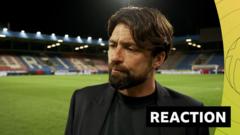How Did Steven Spielberg Revolutionize Action Scenes?

Exploring the Cinematic Impact of "Saving Private Ryan"
Steven Spielberg's "Saving Private Ryan" is not just a film; it's a visceral experience that immerses viewers in the brutal realities of war. The film's iconic opening sequence, which spans 23 minutes, captures the D-Day landings at Omaha Beach with such stark realism that it leaves an indelible mark on its audience. Handheld cameras, low angles, and a relentless portrayal of chaos and violence set the tone for what many consider one of the most authentic depictions of war ever filmed.
The Historical Significance of the Film
For many, including cinematographer Oren Soffer, "Saving Private Ryan" served as a powerful educational tool. Soffer recalls seeing the film during a history lesson in middle school, where it vividly brought to life the events of World War II. This educational aspect is crucial; the film does more than entertain; it informs and educates audiences about a pivotal moment in history.
The graphic violence depicted in the film, from the chaos of battle to the poignant moments of human suffering, resonates deeply with viewers. It forces audiences to confront the harsh realities of war, making it a significant cultural touchstone in the portrayal of military conflict in cinema.
The Cinematic Techniques that Redefined a Genre
Oren Soffer's reflections on "Saving Private Ryan" highlight how Spielberg and his longtime cinematographer, Janusz Kaminski, revolutionized film techniques. The use of handheld cinematography, long lenses, and shaky cam created an immersive experience that placed viewers right on the battlefield. This approach was groundbreaking at the time and has since influenced countless filmmakers.
By employing these techniques, Spielberg succeeded in crafting a sense of authenticity that had not been seen before. The chaotic environment of Omaha Beach, complete with the sounds of gunfire and the cries of wounded soldiers, pulls the audience into the action, making them feel like active participants rather than passive observers.
The Evolution of War Films Post "Saving Private Ryan"
The impact of "Saving Private Ryan" extends far beyond its release. Spielberg is credited with paving the way for a new era of war films that prioritize realism and visceral storytelling. Films like "The Bourne Identity" and even more recent projects like "The Creator" have drawn inspiration from Spielberg’s innovative techniques.
In "The Creator," director Gareth Edwards incorporates similar cinematic strategies to convey a sense of urgency and realism. The film, set in a futuristic world where humans and AI robots are in conflict, utilizes the same bag of tricks that Spielberg employed during the D-Day sequence. This continuity in cinematic language highlights the lasting influence of "Saving Private Ryan" on filmmakers across genres.
The Role of Tactileness in Cinematic Storytelling
One of the key elements that Oren Soffer emphasizes in the making of "The Creator" is the concept of tactileness. For a sci-fi film to feel real and believable, it must engage the audience's senses in a way that mirrors the visceral impact of "Saving Private Ryan." Techniques such as handheld cinematography and the use of long lenses help create a tactile experience that draws viewers into the story.
Visual Style and Directing Techniques
Soffer also discusses Spielberg’s unique visual style, particularly his approach to shot composition. Unlike many directors who meticulously plan every shot in advance, Spielberg often arrives on set without a shot list. This intuitive method allows him to adapt to the unfolding action organically, resulting in a more dynamic storytelling style. This practice enhances the film's realism and emotional impact, contributing to the overall effectiveness of the narrative.
This fluidity in directing is echoed in Gareth Edwards' approach, which may not be a direct imitation of Spielberg but demonstrates a shared philosophy of storytelling. The ability to react to the moment as it occurs on set creates a sense of authenticity that resonates with audiences.
The Use of Color and Texture in Cinematography
Another innovative aspect of "Saving Private Ryan" is Kaminski's use of desaturation. This technique, which predates digital color grading, adds a layer of realism to the film. By intentionally dulling colors and emphasizing textures, the film evokes a sense of grit and grime, effectively conveying the harsh realities of war.
The result is a visual experience that feels raw and unfiltered. The audience can almost feel the rain, mud, and blood, immersing them further into the narrative. Such techniques have influenced the visual style of many subsequent films, proving the lasting impact of "Saving Private Ryan" on cinematography.
Legacy and Impact on Future Filmmakers
The legacy of "Saving Private Ryan" is not confined to its box office success or critical acclaim; it has fundamentally altered the landscape of filmmaking. The film's gritty realism and innovative techniques have set a new standard for how war is depicted on screen. As filmmakers continue to explore the complexities of human conflict, the influence of Spielberg's masterpiece remains evident.
Modern directors often cite "Saving Private Ryan" as a reference point when crafting their own war narratives or action sequences. From the visceral portrayal of combat to the emotional weight of personal sacrifice, the film has shaped the way stories are told in cinema today.
Conclusion: The Power of Film as a Historical Educator
As we reflect on the cinematic achievements of "Saving Private Ryan," it becomes clear that film has the power to educate and evoke empathy. By bringing historical events to life with such authenticity, Spielberg has created a work that transcends entertainment. It invites viewers to engage with the past in a way that is both impactful and meaningful.
In a world where the horrors of war can often feel distant or abstract, "Saving Private Ryan" serves as a reminder of the sacrifices made during pivotal moments in history. It continues to inspire filmmakers and audiences alike, encouraging future generations to explore the complex realities of humanity.
FAQs
What techniques did Spielberg use in "Saving Private Ryan" to create realism?
Spielberg employed handheld cinematography, long lenses, and shaky cam to immerse audiences in the action, creating a visceral experience of war.
How did "Saving Private Ryan" influence modern filmmaking?
The film set a new standard for realism in war movies and has inspired numerous filmmakers to adopt similar techniques in their storytelling.
What role does cinematography play in the impact of "Saving Private Ryan"?
Cinematography is crucial in creating an emotional and immersive experience for viewers, allowing them to feel the intensity and horror of battle.
As we continue to explore the depths of human experience through film, how can we ensure that the lessons learned from "Saving Private Ryan" remain relevant for future generations? #SavingPrivateRyan #Cinematography #FilmHistory
```Published: 2025-08-12 18:38:14 | Category: Trump GNEWS Search



